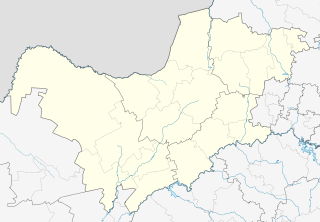
Mining in South Africa was once the main driving force behind the history and development of Africa's most advanced and richest economy. Large-scale and profitable mining started with the discovery of a diamond on the banks of the Orange River in 1867 by Erasmus Jacobs and the subsequent discovery and exploitation of the Kimberley pipes a few years later. Gold rushes to Pilgrim's Rest and Barberton were precursors to the biggest discovery of all, the Main Reef/Main Reef Leader on Gerhardus Oosthuizen's farm Langlaagte, Portion C, in 1886, the Witwatersrand Gold Rush and the subsequent rapid development of the gold field there, the biggest of them all.
Uranium production is an important part of the African economy, with Niger, Namibia, Libya and South Africa creating up to 18% of the world's annual production. Many African countries produce uranium or have untapped uranium ore deposits.
The KDC mine, formerly the Kloof mine, is a large mine located in the northern part of South Africa in Gauteng, and represents one of the largest uranium reserves in South Africa having estimated reserves of 256.4 million tonnes of ore grading 0.0036% uranium.
The South Deep mine is a large mine located in the northern part of South Africa in Gauteng. South Deep represents one of the largest uranium reserves in South Africa having estimated reserves of 126 million tonnes of ore grading 0.0062% uranium.
The Buffelsfontein mine is a large mine located in the northern part of South Africa in Gauteng. Buffelsfontein represents one of the largest uranium reserves in South Africa having estimated reserves of 59.3 million tonnes of ore grading 0.016% uranium.
The Hartebeestfontein Mine is a large mine located in the northern part of South Africa in Gauteng. Hartebeestfontein represents one of the largest uranium reserves in South Africa having estimated reserves of 641 million tonnes of ore grading 0.007% uranium.
The Randfontein mine is a large mine located in the northern part of South Africa in Gauteng. Randfontein represents one of the largest uranium reserves in South Africa having estimated reserves of 131.2 million tonnes of ore grading 0.066% uranium.
The Beaufort West mine is a large mine located near Beaufort West in the northern part of South Africa in Western Cape. Beaufort West represents one of the largest uranium reserves in South Africa having estimated reserves of 23 million tonnes of ore grading 0.08% uranium.
The Kopanang mine is a large mine located in the northern part of South Africa in Gauteng. Kopanang represents one of the largest uranium reserves in South Africa having estimated reserves of 37.1 million tonnes of ore grading 0.065% uranium.
The Moab Khotsong mine is a large mine located in the northern part of South Africa in North West some 180 kilometers southwest of Johannesburg, South Africa. Moab Khotsong represents one of the largest uranium reserves in South Africa having estimated reserves of 57.2 million tonnes of ore grading 0.058% uranium.
The Vaal River mine is a large mine located in the northern part of South Africa in Gauteng. Vaal River represents one of the largest uranium reserves in South Africa having estimated reserves of 379.2 million tonnes of ore grading 0.0076% uranium.
The West Wits mine is a large mine located in the northern part of South Africa in Gauteng. West Wits represents one of the largest uranium reserves in South Africa having estimated reserves of 173.9 million tonnes of ore grading 0.0059% uranium.
The Rietkuil mine is a large mine located in the northern part of South Africa in Gauteng. Rietkuil represents one of the largest uranium reserves in South Africa having estimated reserves of 127.8 million tonnes of ore grading 0.043% uranium.
The Denny Dalton mine is a large mine located in the northern part of South Africa in Gauteng. Denny Dalton represents one of the largest uranium reserves in South Africa having estimated reserves of 31.2 million tonnes of ore grading 0.03% uranium.
The Old Randfontein mine is a large mine located in the northern part of South Africa in Gauteng. Old Randfontein represents one of the largest uranium reserves in South Africa having estimated reserves of 247.2 million tonnes of ore grading 0.025% uranium.
The Mintails mine is a large mine located in the northern part of South Africa in Gauteng. Mintails represents one of the largest uranium reserves in South Africa having estimated reserves of 210.3 million tonnes of ore grading 0.0046% uranium.
The Ergo mine is a large mine located in the northern part of South Africa in Gauteng. Ergo is one of the largest uranium reserves in South Africa, having estimated reserves of 173.5 million tonnes of ore grading 0.0033% uranium.
The Beisa North mine is a large mine located in the northern part of South Africa in Gauteng. Beisa North represents one of the largest uranium reserves in South Africa having estimated reserves of 27.9 million tonnes of ore grading 0.066% uranium.
The Karoo mine is a large mine in the northern part of South Africa in Gauteng. Karoo represents one of the largest uranium reserves in South Africa having estimated reserves of 22.1 million tonnes of ore grading 0.089% uranium.



